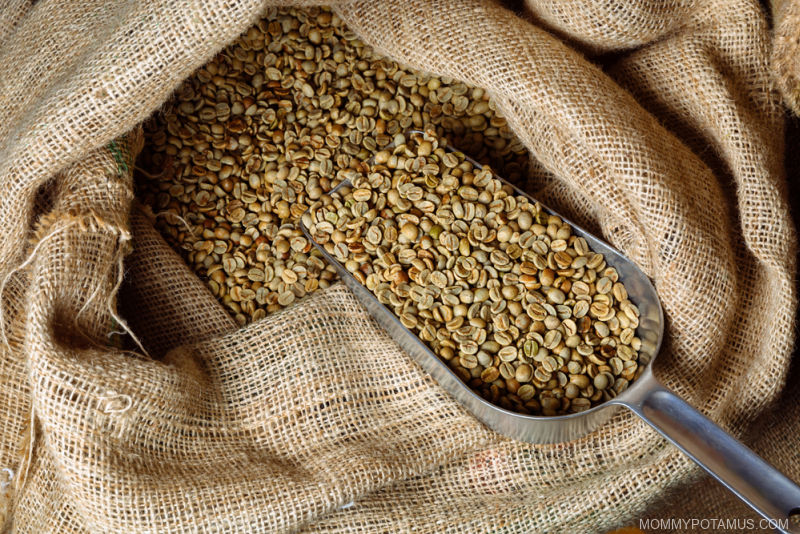
When I say “benefits of coffee,” what comes to mind? Is it the piles of research on its bioactive compounds . . . or the fact that life just seems to go more smoothly with a warm cup of joe? Either way, coffee is an integral part of many of our mornings, and for good reason.
It’s one of the most potent sources of antioxidants in the human diet, mostly thanks to a compound you may not have heard of before – chlorogenic acid (CGA). 1
Not all coffee is rich in CGA, though. Long roasting times and/or high temperatures can reduce CGA concentrations, which is why some people supplement with green coffee extract. Fortunately, it’s possible to get high CGA coffee by choosing specific roasts. 2
I’ll cover the benefits of chlorogenic acid below, plus how to choose high CGA coffee. As always, none of these statements have been evaluated by the FDA, this article is not medical advice, and it’s not meant to diagnose or treat any condition. Now that we’ve got that out of the way, let’s dive in . . .

What is chlorogenic acid?
CGA is a potent polyphenol that’s thought to be the main compound responsible for coffee’s health benefits. It’s found in green coffee beans, brewed coffee (to a greater or lesser extent depending on roasting time and temperature), blueberries, sunflower seeds, black tea, and green tea. 3
Significantly smaller amounts can also be found in foods including apples, pears, eggplant, blueberries, tomatoes, and potatoes, but the concentrations are not high enough to have much of a biological effect.
Also known as 3-caffeoylquinic acid, this ester of caffeic acid and quinic acid “strongly influences the taste of coffee, such as astringent, sweet, and sour tastes, which change with the concentration.” 4
The most notable difference between high and low CGA coffee is the acidity level. Unroasted or lightly roasted coffee contains the most CGA along with the highest acidity levels, while low-CGA dark roasts are less acidic.
Personally, I like coffee that has been lightly roasted to improve flavor and decrease some of the acidity while still preserving a substantial amount of CGA. My favorite is Purity Coffee – more on why later in this article.

Benefits of Chlorogenic Acid
Current research suggests that CGA positively influences mood, cognitive function, blood sugar balance, metabolism and more. Here’s an overview:
#1 – Mood & Cognitive Support
I often joke that magic beans are real, because my morning coffee transforms ho-hum mornings into ones that are productive and enjoyable. Part of that is due to the caffeine, but CGA also has a mild psychostimulatory effect. 5
That may be why – in this study – even decaf coffee enriched with chlorogenic acid supported mood and attention. The mood benefits may be due to an influence on the production of serotonin along with longevity support for dopamine-producing brain cells. 6 7
#2 – Blood Sugar Support
As you’ve probably experienced at some point, blood sugar spikes and crashes can seriously mess with our focus, energy levels, and mood. The benefits of avoiding those rollercoaster ups and downs goes beyond just the temporary discomfort, though – having consistently balanced blood sugar levels is associated with increased longevity, hormone health, mental clarity, stable energy levels, and more.
There are a lot of factors that influence how well our bodies manage blood sugar levels – getting good sleep, sunlight, time outdoors and exercise all increase our ability to effectively manage the natural ebb and flow of dietary carbs and sugar. 8 9 10 11
Antioxidants play a significant role, too, and chlorogenic acid specifically is thought to help in a couple of different ways including:
Carbohydrate Metabolism – CGA seems to downregulate the activity of an enzyme called alpha-glucosidase, which is responsible for breaking down carbohydrates so they can be released as glucose into our bloodstream. 12
In this study, rats who received CGA with their meals broke down fewer carbs and had lower amounts of a particular glucose marker (glucose-dependent insulinotropic peptide) in their blood. Human studies indicate similar effects. For example, in this clinical trial, participants who took an oral glucose tolerance test experienced better blood sugar balance when they also took chlorogenic acid and trigonelline (another compound that is commonly found in coffee).
Insulin Sensitivity – In this small study, women who took 400 mg of chlorogenic acid extract three times per day experienced a positive impact on insulin sensitivity. In other words, they had a stronger cellular response to the hormone insulin, which helped to optimize the use of blood glucose. Other research done with supplements containing chlorogenic acid combined with other nutraceuticals like tocotrienols and vitamin C found similar effects. 13 14
Note: Because of its influence on carbohydrate and blood sugar metabolism, chlorogenic acid may amplify the effects of blood sugar lowering drugs like metformin. 15 Individuals taking medication for high blood sugar should talk to their healthcare provider before taking chlorogenic acid extract supplements.
#3 – Supports Metabolism
Research suggests that chlorogenic acid supports thermogenesis, which is when our bodies burn calories as fuel. 16 In one small study, healthy volunteers who took a CGA-rich drink for five days burned more fat while they slept. 17
Animal studies have reported similar results. 18
#4 – Antioxidant Support
Our bodies break down toxins via oxidation – a process that transforms them into water-soluble compounds that can be flushed out of the body. Oxidation produces free radicals, which can damage tissues and accelerate aging unless they are neutralized by antioxidants.
Coffee provides antioxidant support in two ways by:
- Directly supplying the body with chlorogenic acid
- Supporting the production of the body’s master antioxidant: glutathione 19 20 21

Does coffee support cardiovascular health?
Research suggests that coffee consumption may have a positive influence on blood lipids, including LDL (bad) cholesterol and HDL (good) cholesterol. 18 22 23 24
According to some studies it may also beneficially impact blood pressure, while other research indicates that consumption – especially in excessive amounts – can raise levels. 25
There are probably a few reasons for the conflicting findings, one of which is the actual composition of the coffee we’re drinking.
That’s because while caffeine can raise blood pressure, “there are many other substances in coffee, such as polyphenols, soluble fibre and potassium, which could exert a beneficial effect in the cardiovascular system.” 25
As you know, CGA is coffee’s main bioactive polyphenol, so it’s no surprise that research has been done on how it impacts blood pressure and other measures of vascular function. For example:
- In this clinical trial, regular consumption of high CGA coffee (in the form of 35% green coffee blended with 65% roasted coffee) positively influenced blood pressure, metabolism, and plasma antioxidant capacity.
- In this study, researchers gave participants coffee with identical amounts of caffeine but different amounts of CGA. The higher CGA coffee positively impacted flow-mediated dilatation, which is a measure of vascular function. The researchers believe that CGA likely influences the bioavailability of nitric oxide, which is a vasodilator that relaxes the inner muscles of blood vessels. This vasorelaxation effect allows blood vessels to widen, which increases blood flow and eases tension within vessel walls.
- In this study, researchers compared the effects of chlorogenic acid-rich green coffee with regular black coffee. They found that the higher CGA coffee positively influenced arterial elasticity, blood pressure, and body composition. Green coffee is pretty acidic in flavor, so I opt for a lightly roasted coffee that is around 65% higher in CGA than other organic coffee brands.
With all that said, it’s important to remember that the caffeine in coffee can have negative impacts if consumed in excess. I think Purity Coffee explains it well in this article:
If you have been diagnosed with hypertension, you should not increase your caffeine consumption without first speaking to your doctor, since findings show progressively larger blood pressure responses to caffeine in persons with increasing risk of hypertension. Some people are fast metabolizers of caffeine, and some are slow metabolizers.
Your body knows how much caffeine you can tolerate. So, listen to your body. If you start to feel that jittery feeling, you have likely reached your body’s threshold for caffeine. Scientific evidence indicates that for the general population of healthy adults, moderate caffeine intake is not associated with commonly cited adverse effects.
Acceptable caffeine levels for most adults with no major health issues: 4 mg per body X weight: 400 mg per day should be the max (4-5 cups of brewed coffee) While the health benefits are linearly correlated with the amount of coffee drunk, it is best not to exceed 5-6 cups, since high amounts of caffeine may be detrimental.
At Purity our recommendation is not necessarily MORE coffee– it’s BETTER coffee.”
Does chlorogenic acid have any side effects?
Allergic reactions to green coffee bean extract have been reported. 26 The reactions did not seem to be due to chlorogenic acid, so another constituent in green coffee is likely the issue. 27
If you’re taking any prescription medications, it’s always a good idea to check with your healthcare provider about potential interactions or contraindications before starting a new supplements or dietary intervention.

How To Choose High CGA Coffee
Unroasted green coffee contains the most CGA, but it also contains the least amount of caffeine. 28 I want both, so I choose light to medium roasts.
Purity Coffee is one of my favorite options because they use smokeless roasting to maximize the things we want (like CGA) while avoiding the things we don’t (like damaging polycyclic aromatic hydrocarbons that are formed when beans are over-roasted). They’re also:
- Organic
- Mold and mycotoxin free
- Rainforest Alliance Certified (meaning their practices are sustainable).
In terms of chlorogenic acid, independent lab testing shows that their two light/medium roasts – PROTECT and FLOW – contain approximately 65% more CGA than other organic brands. EASE still contains CGA, but it’s roasted longer to reduce acid content for people with sensitive stomachs. The final amount of CGA is about half of the concentrations found in FLOW.
They also offer CALM, which uses a chemical-free natural water process to remove 99.9% of the caffeine while preserving high CGA content.
If you want to try them out, you can save 20% on your first order with code MP20 + FREE shipping.
Click here and use code MP20 to save
Are you familiar with adaptogens?
Adaptogens are one of the most beneficial types of herbs for stressed, tired moms, but there’s a lot of uncertainty about what’s safe for pregnancy and nursing. I’ve created a free ebook for you – The Beginner’s Guide to Adaptogens – as a gift for signing up for my newsletter.
I researched ten different herbs in the Botanical Safety Handbook and wrote several herb profiles that include benefits, safety info, and recommendations from an expert (ethnobotanist) on how to take them. As a subscriber, you’ll also get updates when I post new recipes and research, exclusive sales and coupons on my favorite products.
Sign up using the form below.
- Arne Svilaas et. al. (2004) Intakes of antioxidants in coffee, wine, and vegetables are correlated with plasma carotenoids in humans
- Iziar A. Ludwig et. al. (2014) Variations in caffeine and chlorogenic acid contents of coffees: what are we drinking?
- The Marshall Protocol Knowledge Database. Chlorogenic Acid
- Kunisuke Izawa et. al. (2010) Comprehensive Natural Products II
- Ryoko Ohnishi et. al. (2006) Effects of chlorogenic acid and its metabolites on spontaneous locomotor activity in mice
- Jianming Wu et. al. (2006) Antidepressant Potential of Chlorogenic Acid-Enriched Extract from Eucommia ulmoides Oliver Bark with Neuron Protection and Promotion of Serotonin Release through Enhancing Synapsin I Expression
- Wenjuan Shen et. al. (2012) Chlorogenic acid inhibits LPS-induced microglial activation and improves survival of dopaminergic neurons
- Kristen L Knutson (2008) Impact of sleep and sleep loss on glucose homeostasis and appetite regulation
- Sue Penckofer et. al. (2010) Vitamin D and Diabetes Let the Sunshine In
- Catherine Shore-Lorenti et. al. (2014) Shining the light on Sunshine: a systematic review of the influence of sun exposure on type 2 diabetes mellitus-related outcomes
- Northwestern University (2016) Bright light alters metabolism
- Wafaa Benalla et. al. (2010) Antidiabetic medicinal plants as a source of alpha glucosidase inhibitors
- Arrigo FG Cicero et. al. (2015) Short-term effects of a combined nutraceutical of insulin-sensitivity, lipid level and indexes of liver steatosis: a double-blind, randomized, cross-over clinical trial
- Arrigo Francesco Giuseppe Cicero et. al. (2019) Three-arm, placebo-controlled, randomized clinical trial evaluating the metabolic effect of a combined nutraceutical containing a bergamot standardized flavonoid extract in dyslipidemic overweight subjects
- Pranav Kumar Prabhakar 1 and Mukesh Doble (2009) Synergistic effect of phytochemicals in combination with hypoglycemic drugs on glucose uptake in myotubes
- Liliya V. Vasileva et. al. (2020) Caffeic and Chlorogenic Acids Synergistically Activate Browning Program in Human Adipocytes: Implications of AMPK- and PPAR-Mediated Pathways
- Insung Park et. al. (2017) Effects of subacute ingestion of chlorogenic acids on sleep architecture and energy metabolism through activity of the autonomic nervous system: a randomised, placebo-controlled, double-blinded cross-over trial
- Ae-Sim Cho et. al. (2010) Chlorogenic acid exhibits anti-obesity property and improves lipid metabolism in high-fat diet-induced-obese mice
- Roghayeh Rashidi et. al. (2022) A review of the protective effects of chlorogenic acid against different chemicals
- Lili Ji et. al. (2013) Chlorogenic acid, a dietary polyphenol, protects acetaminophen-induced liver injury and its mechanism
- Narges Tajik et. al. (2017) The potential effects of chlorogenic acid, the main phenolic components in coffee, on health: a systematic review of the literature
- Harumi Uto-Kondo et. al. (2010) Coffee Consumption Enhances High-Density Lipoprotein-Mediated Cholesterol Efflux in Macrophages
- H.V. Sudeep et. al. (2016) Biomechanism of chlorogenic acid complex mediated plasma free fatty acid metabolism in rat liver
- Sara Martínez-López et. al. (2019) Moderate consumption of a soluble green/roasted coffee rich in caffeoylquinic acids reduces cardiovascular risk markers: results from a randomized, cross-over, controlled trial in healthy and hypercholesterolemic subjects
- Johanna M Geleijnse (2008) Habitual coffee consumption and blood pressure: an epidemiological perspective
- E Zuskin et. al. (1985) Bronchial reactivity in green coffee exposure
- Xiaodong Wu et. al. (2010) Comprehensive research and evaluation of chlorogenic acid allergy
- Shady Awwad et. al. (2021) Quantification of Caffeine and Chlorogenic Acid in Green and Roasted Coffee Samples Using HPLC-DAD and Evaluation of the Effect of Degree of Roasting on Their Levels







